It must be time to update our NEWS! The winter weather has meant that we have virtually closed down the workshop and adjourned to the warmth of our house. Liz has joined a new print making group in Lewes and embarked on learning new skills of drypoint. Pete is considering whether to continue the set of paintings on seaside iconography mentioned in the previous post, or return to an earlier theme of ‘Sweet Thames’. Meanwhile he has completed a new group of paintings of local trees, a hedge and reeds to join earlier examples. It would be nice to think these belong to the same world Caroline Lucas evokes in her selection from the Towner (see below).
Aside from a run of the all too common hospital visits, we’ve visited five exhibitions since December including two private views. And thanks to the Depot cinema, we’ve seen several films – including a showing of the John Ford classic The Searchers on the big screen. So far Marriage Story and Parasite get our votes; as does Adam Driver, minus his role in The Rise of Skywalker. Little Women and David Copperfield were forgettable – we thought – and 1917 was deserving. On TV Sam Mendes talked expertly, with modesty and charm, about his favourite films. But the thing to know about Sam is that Pete taught for many years alongside his dad, Peter Mendes, at Thames Polytechnic/ the University of Greenwich (!)
In December we caught the latest Collection exhibition at the Towner, curated by Caroline Lucas and titled ‘Brink’ (running until 20 May). Lucas has chosen a varied selection of landscapes from the Towner’s stock of 5000 works. They gelled, not surprisingly with environmental concerns and current issues but evoked too a less troubled, deep and simple pleasure in landscape. One of the most remarkable examples in her selection was Robert Morris’s small pencil, ink and watercolour drawings in a diary of 1878-9. Other works we found striking were William Nicholson’s ‘Judd’s Farm’ (1912), Charles Knight’s ‘Ditchling Beacon’ (1930), Victor Pasmore’s ‘The Front at Seaford’ and Ian Southam’s photograph of Cuckmere Haven (1999).

Of the pictures she considered, and her title, Lucas said,
‘You really got the sense of edges… That grew into this sense of being on the brink, on the edge of something new, politically, in the broadest sense. Whether or not we rise to the climate challenge, whether or not Brexit gets resolved, whether or not we have a kinder more compassionate politics going forward. It feels like we are metaphorically on the edge, just as so many of the artworks I was looking at played with the idea of different planes, different edges.’
When we visited, this exhibition was partnered by another of the work of sculptor David Nash, titled ‘200 Seasons’ (until 2 Feb 2020). Here, film and drawings accompanied dramatic examples of his large, muscular and simply amazing sculptures in wood, drawn from woodland in Wales, especially at Capel Rhiw, Blaenau Ffestiniog, his long-time home and the site of his studio.
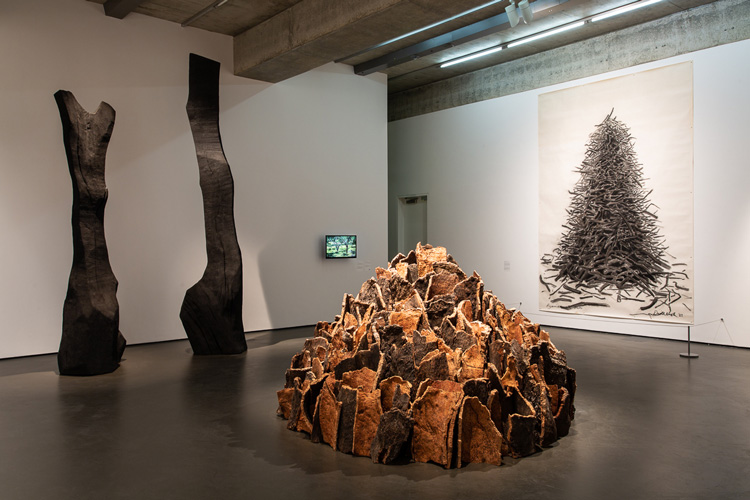
In January we very much enjoyed an exhibition at Charleston demonstrating the work and activities of the London based Omega Workshop, founded in 1913 by Roger Fry, Vanessa Bell and Duncan Grant in a desire to extend a ‘post-impressionist’ modernist aesthetic to the circumstances and needs of everyday life. The Workshop closed in 1919 so the exhibition effectively celebrated its centenary. The result was an unprecedentedly comprehensive display of what it produced, from a dinner invitation announcing the movement, to posters, book illustrations, fabrics, ceramics, clothes, furniture and exterior design. In its own day, the Omega was rivalled by another- Vorticist- movement, championed by Wyndham Lewis and others which split from Fry’s workshop. Both movements belonged to the dynamic innovative impulse of the 1910s (see below on Pallant House), but its absence here does not detract from the marvellously full story the exhibition tells of the Omega itself.
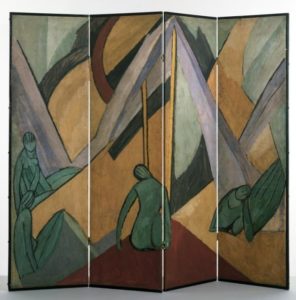
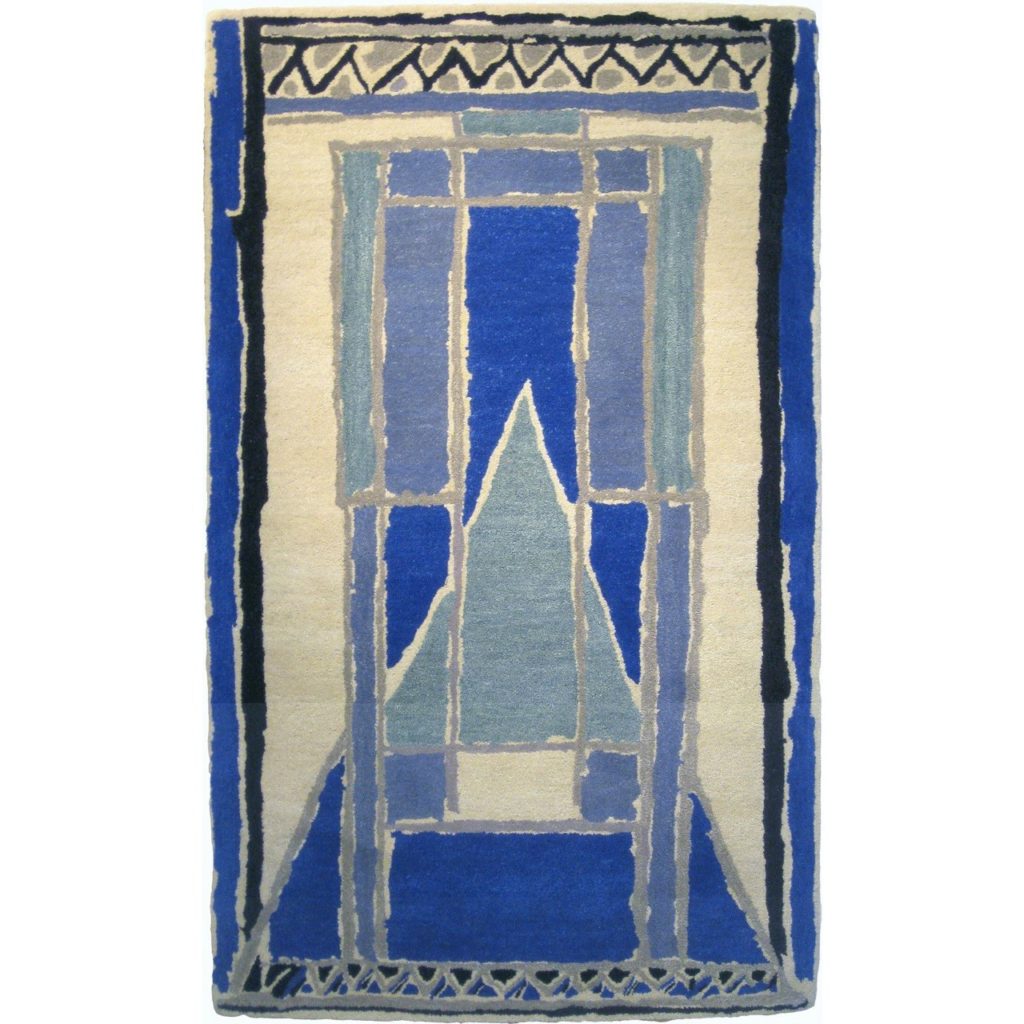
Later in January we visited the Pallant House Gallery In Chichester to see the wide and absorbing exhibition ‘Radical Women. Jessica Dismorr and her Contemporaries’(until 23 Feb). Jessica Dismorr (1885-1939) was a signatory and contributor to the Vorticist manifesto tabled in the magazine Blast (1914), as was Helen Saunders, also shown in the exhibition. It includes examples of her work of this period but much more as she joined other individuals, groups and movements, for example the ‘Rhythm’ group and magazine, through to the late 1930s, moving through different styles and engaging in different radical campaigns, for suffrage and anti –fascism, as she did so. Several works by Dismorr and Saunders and others, for example Winifred Nicholson and Barbara Hepworth, have their first showing here. Much of the work was entirely new to us and the exhibition does a wonderful job in recovering the experimental and politically committed drive linking Dismorr, her colleagues and associates.
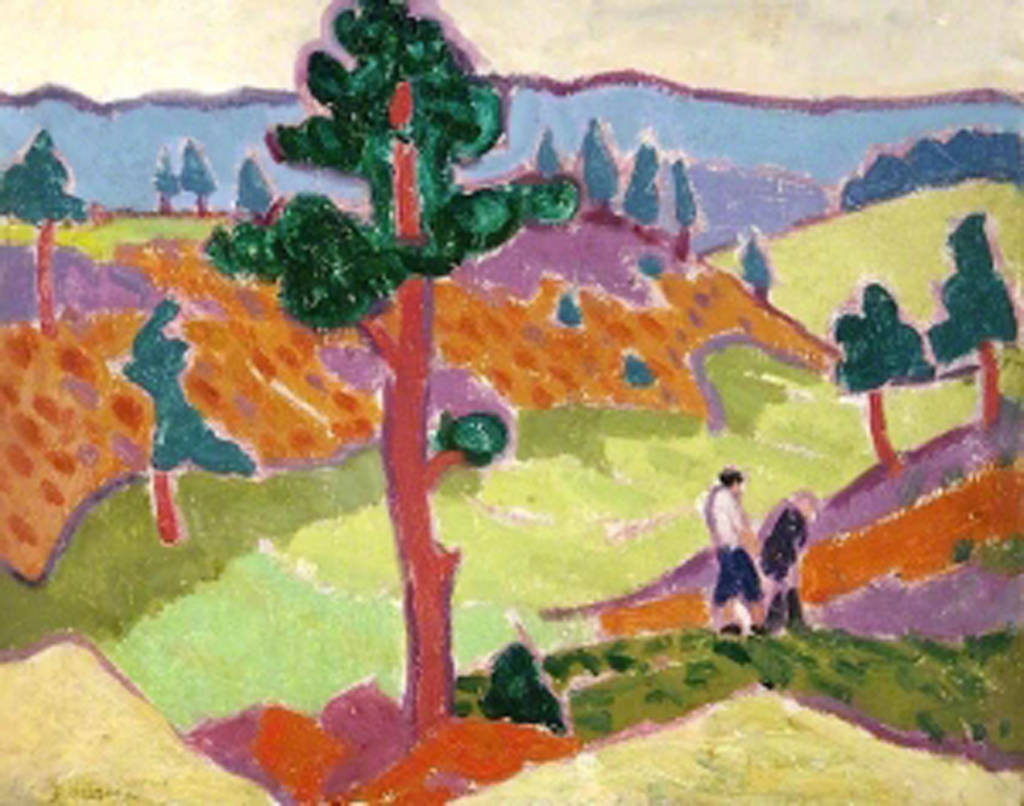
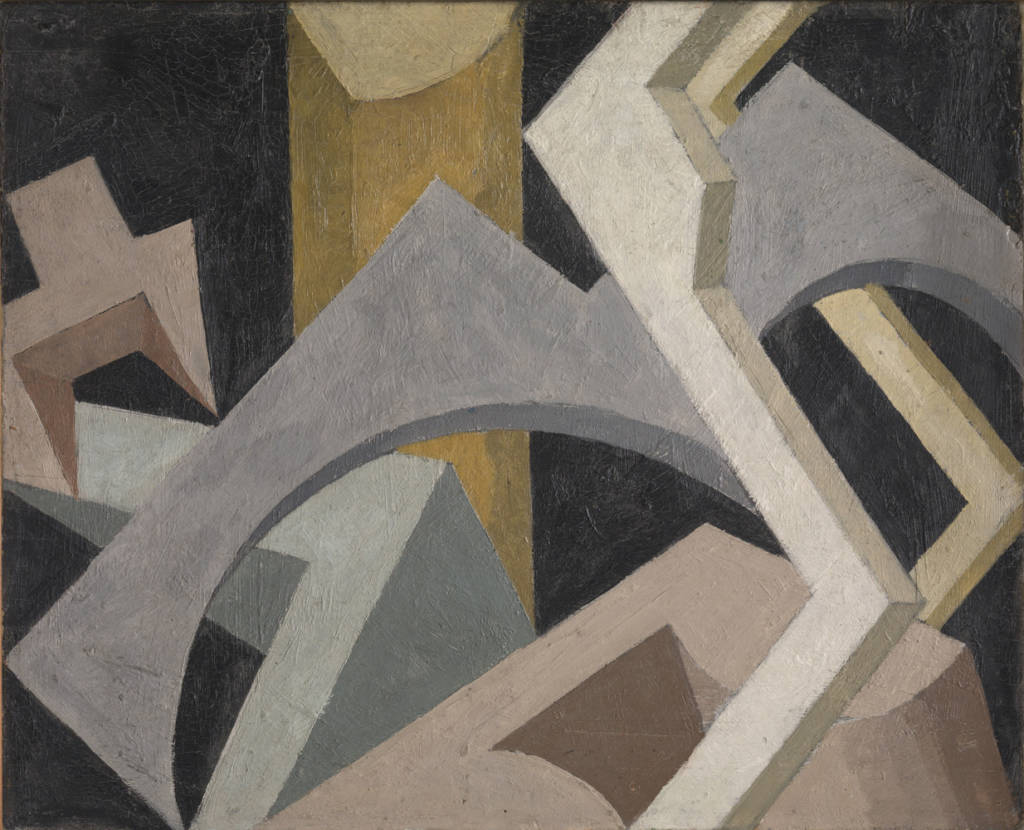
In February we milled with other Towner members to see youthful work by Alan Davie and David Hockney (from Feb 15- May 31). This follows an original exhibition at the Wakefield Art Gallery marking the date of the first exhibition of Davie’s work there in 1958, which the young Hockney attended. He felt that Davie liberated him to experiment with form and colour. A few works here do suggest a debt to Davie’s rough vigour, classed as abstract expressionism, but these are less engaging – we agreed – than the wit, evident skill and bold composition the young Hockney came to show. The difference in approach emerges quite clearly in fact. Whereas Davie wrote how ‘painting just happens’, Hockney, in a short film included here, carefully explains ‘this is what I did’ in talking us through making an etching.
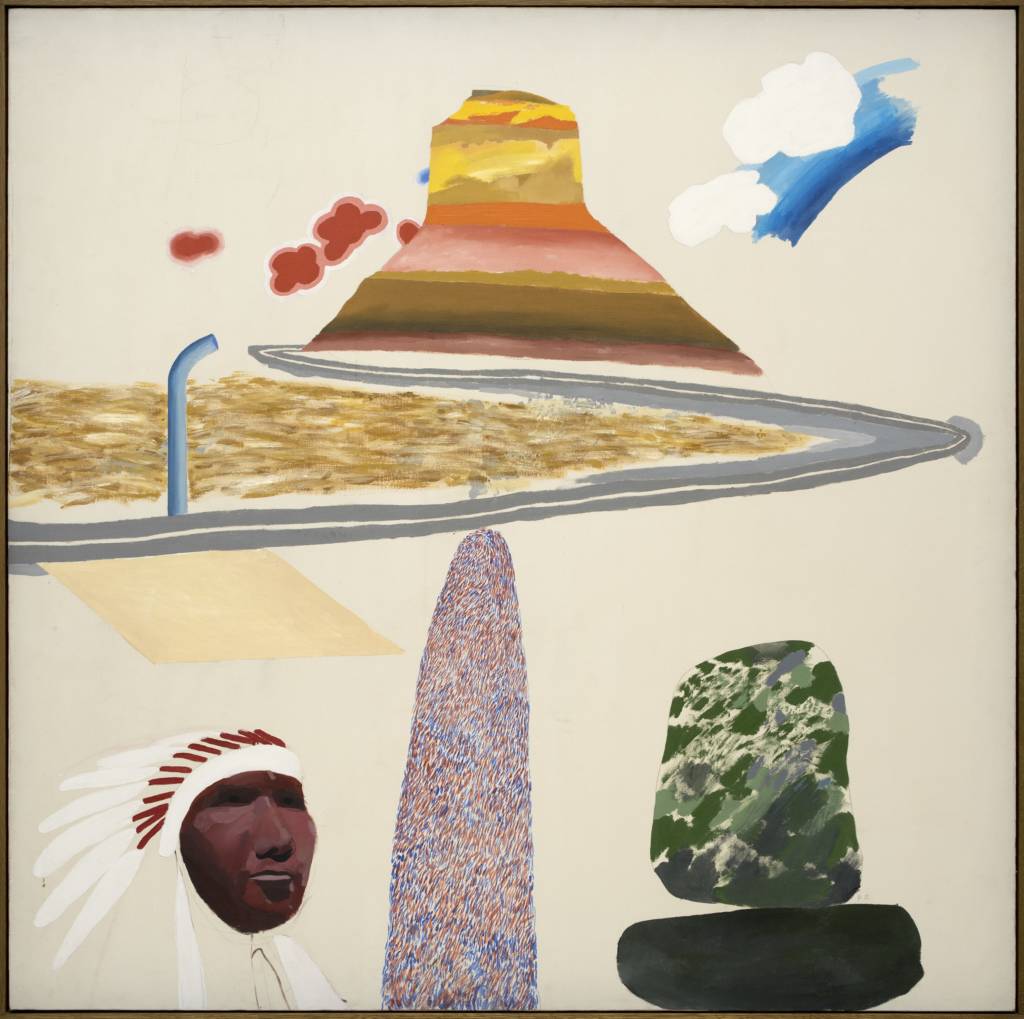
The next day – as it turned out, in wretched weather – we sought out the studio, at the end of a fabulously stocked long barn, used by Lewes based artist Julian Bell (the son of Quentin Bell and grandson of Vanessa Bell). This included some recent drawings and small paintings, but the primary focus was the series of works comprising his new work ‘When the City is Built’. This depicts scenes comprising a day in the life of London (in an office, a market, a rooftop club, a building site, a mother and child watching TV) and featuring a recurring set of imagined characters. Bell brings a practised eye to bodily shape and movement and his fluent skill is evident here and in preliminary sketches as well as in other drawings. His use of colour and composition, too, varies impressively scene by scene. Of his purpose in this series he writes:
“I hope it says that painting is a good way of thinking about contemporary life and the textures of experience. What things feel like these days. I want to show the maelstrom of the contemporary world: there are divine possibilities, but more of the time you are in the middle of the shit.”
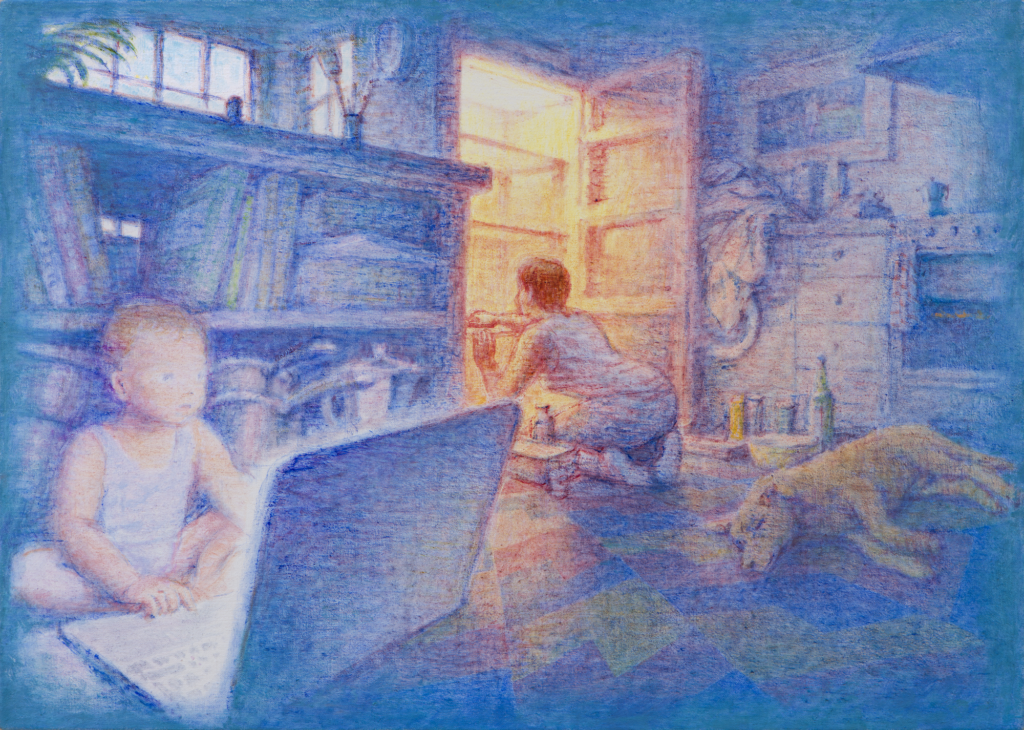
This show was limited to two days. We thought of buying a small Julian Bell painting but emerged only with a signature to our copy of his very good book What is Painting?
July – December 2019
A strange set of months. We took part in Art Wave in August and were asked to exhibit our work at the Chiddingly festival in September. These were good events where we were able to show some new work and, which, as usual, included a welcome number of chats with visitors who wanted to comment on or ask about our work or discuss their own. We had little opportunity to visit other Art Wave venues but did enjoy the work of local photographer Rick Turner and the textiles of his wife Louise. It was good to meet them and know there are other fellow makers in Ringmer.
There was, however, a long shadow over these events and the following months. Pete was hospitalised with sepsis in the middle of Art Wave and was self-monitoring on new medication for a subsequent three months. Liz suffered bravely meanwhile with hyperparathyroidism. Her condition deteriorated and she had an operation in November, followed by a month or more of close monitoring and tests. Which continue.
What happened to our art work? Well, it stalled, soon to be dwarfed by the election campaign and the nightmare of King Boris. Pete did start a possible series of small paintings of seaside scenes and iconography. The result is three pictures: of a paddle steamer, a bandstand, and an amusement complex remembered from his boyhood and youth living in Southend. Yes, it sounds like and is a nostalgic bid for simpler times. We did combine on making a Christmas card featuring turtle doves and a partridge. We wondered if our note that these are threatened birds might prove too sombre a message but friends’ reactions gratifyingly proved otherwise.